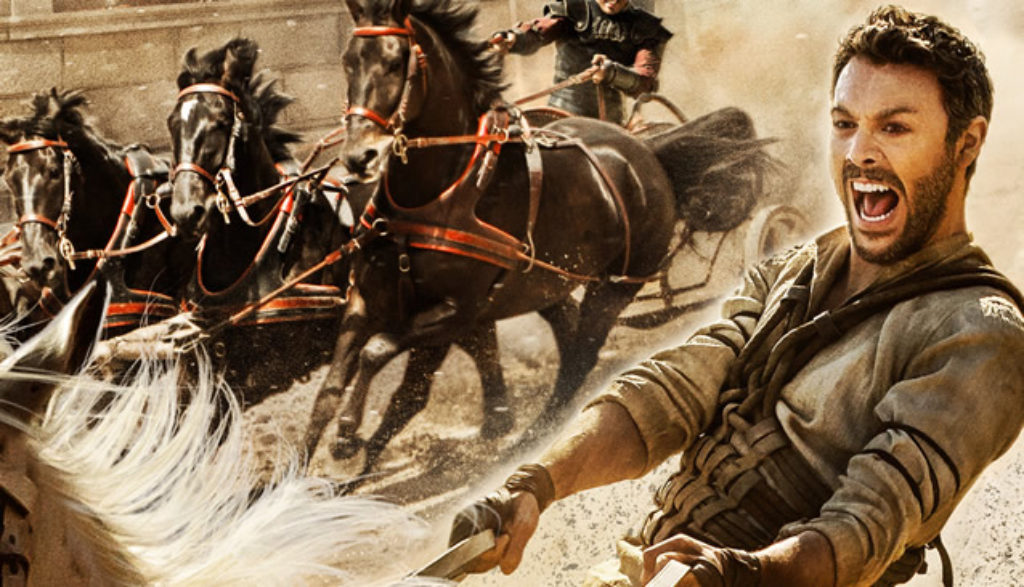
Back in the day of Caesar Augustus, Jews and Romans got along about as well as the Hatfields and McCoys—if the McCoys had all the guns and the Hatfields had all the sticks that might’ve looked like guns, of course. But even amid this fractious relationship between two very different peoples, there were pockets of comradery—like the one we find in the house of Hur.
Judah Ben-Hur and Messala Severus are brothers. Sorta. When Messala was orphaned, the Hur family decided to take the little waif in and raise him as its own. Sure, they don’t share the same blood: Messala is a Roman, after all. And when he and his “sister” Tirzah bat their eyelids at each other, it’s clear they share more than just a sibling-like affection. As far as Judah is concerned, however, they might as well be twins.
But it rankles Messala that he owes the Hurs pert near everything. And he knows that the family matriarch, Naomi, won’t ever accept him as a suitable suitor for Tirzah—not until he makes a name for himself. So, like many a young man, he decides to leave home and see the world. And given that the Roman legions are tramping all over said world to kill and conquer, he’s got a great opportunity to get paid for it, too.
Three years later, he’s back—all gussied up in shiny Roman armor. He’s ascended to the ranks of middle management, giving orders to lackeys whose armor isn’t quite so shiny, but still polishing the buttons of a commander or two. Now, back in his Judean homeland, he has an opportunity to impress some folks for his next performance review.
But Messala needs help. See, his powerful mentor, Pontius Pilate, is due to ride into Jerusalem soon. The city is riddled with rebellious Zealots, and no one in Rome wants any embarrassing trouble. Would Judah help him keep the peace, he asks?
Judah would and Judah does … to a point. But he’s not going to name names of any Zealots. And when one of these nettlesome rebels shows up injured in the Hur family stables, Judah takes him in. You know, just until he’s feeling better.
Alas for Judah, the man is a fast healer. He’s fit enough to pull a bowstring in no time. And wouldn’t you know it? As Pilate rides in, the Zealot takes a potshot at the Roman from one of the Hur household towers.
The Romans can’t let assassination attempts go unpunished. Led by Messala, soldiers invade Ben-Hur’s house and—as the would-be assassin makes his getaway—pin poor Judah, Naomi and Tirzah to the ground. In an effort to spare his mother and sister, Judah confesses to the crime.
Messala hesitates: His supervisor is beside him. His Roman guardian, Pilate, was just about killed. He looks at his brother, pleading for mercy, and he makes a fateful decision.
“Take them all,” he says. And just like that, the family he owes everything to—the brother he loves, the woman he cherishes—are dragged away to their deaths.
Or so he believes.
Judah Ben-Hur doesn’t die, of course. He lives on, dwelling on this betrayal and hungering for revenge. As such, he’s not a particularly admirable fellow throughout much of the movie. When his beloved, Esther, suggests that “faith brought you back to me,” Judah denies it. “Faith wasn’t strong enough,” he says. “There was hate.”
But hatred and revenge eventually give way to more positive messages of grace and forgiveness, as well as the idea that love really does conquer hate if you let it.
Only two characters consistently embody this philosophy of love and forgiveness throughout the movie. Esther adheres to it passionately, feeding and caring for others when she imagines that Judah’s lost to her forever. And when Judah returns in body but still seems lost, she pleads with both him and Messala to drop their grudge and return to treating each other like real brothers.
The other character is Jesus, whom we’ll talk more about in the next section.
Ben-Hur is based on Lew Wallace’s epic 1880 novel, Ben-Hur: The Tale of the Christ. The title is, obviously, telling: While the narrative centers around Judah Ben-Hur, Jesus is the story’s real architect. While this 2016 re-imagining of the tale takes some liberties with Wallace’s plot, his spiritual elements remain core to the story.
Jesus, as mentioned, is a prime player, constantly preaching the need to love and forgive others. He shelters someone from being stoned. He gives water to Judah as he’s being led off to the slave galleys. He’s always talking about how there’s a better way of doing things, and Jesus is clearly rubbing some important people the wrong way. When Pilate sees Jesus at work, he turns to Messala and suggests that this one man is more dangerous to Rome than Jerusalem’s legion of Zealots. (Never mind that Jesus wasn’t actually in Jerusalem nearly as much as the movie suggests.)
Audiences see critical moments that surround Jesus’ last days, too. Judah talks with Esther, for instance, as she and others carry palm branches—a signal to viewers that Jesus’ crucifixion is approaching. Later, Esther is among the followers in the Garden of Gethsemane as Roman soldiers arrive to take Jesus away. (We see Jesus caution his disciples to not react with violence.) A bloodied Jesus staggers through the streets of Jerusalem, wearing His crown of thorns and carrying the crossbeam, telling a man who tries to give Him water that He’s sacrificing His life of His own free will. And we see Him, naturally, on the cross—asking God to forgive His tormenters, and us, because we know not what we do.
[Spoiler warning] Judah is present for Jesus’ crucifixion, and Jesus stares right at him as He asks for the Lord to forgive them (and him). Judah weeps at the foot of the cross. It’s the catalyst that eventually sends him on a better road, where Judah forgives and asks forgiveness of his nemesis. Jesus’ blood also cures Naomi and Tirzah of leprosy (through bloodstained rainwater filtering into the castle where they’ve been kept imprisoned for lo these many years).
But while Jesus is a major player in the film and a huge influence upon Esther, others are resistant to His message. Judah jokes that Messala worships “359 gods.” The latter totes around Roman idols, leaving one in front of Judah’s door when he’s been gravely injured. (Naomi removes it and gives it back to Messala, curtly telling him, “We have different gods.”) His armor depicts Roman gods and goddesses, as does the Circus where the story’s famous chariot race takes place.
Other Romans take a more humanistic view: A ship commander tells rowers, “Your god is the glory of Rome.” And when Pilate welcomes people to the chariot race, he shouts, “We celebrate the glory of man!”
While Judah is technically Jewish, of course, wearing a Kippah at times, he seems to doubt the whole concept of God. “If God is righteous, we should do righteous things,” Esther tells him. “If there is a God, why does he not do right by the world?” Judah retorts.
Judah and Esther marry while Messala’s away. They kiss on occasion and are shown in bed together. Messala and Tirzah look longingly at each other at times, and Tirzah puts her head on Messala’s shoulder during a night-long vigil. When Esther goes to Messala to convince him to give up his blood-feud with Judah, someone suggestively tells Messala, “She needs you,” followed by much hooting by nearby soldiers. Tirzah, as she’s being led away, has her dress ripped, revealing part of her back. Men are shown bare-chested.
We have to begin with the chariot race, don’t we? The defining scene of every Ben-Hur movie features plenty of fatalities. Chariot racers and would-be Roman helpers are trampled—with one hanging on for dear life on a chariot undercarriage before finally dropping to his squishy doom. Chariot carriages flip. Apparently dead, bloodied bodies are dragged away. In one case, a body is hoisted by celebrants as a horrific trophy of victory. Even survivors are left bloodied and brutalized, and someone loses a leg. The visual impact of the scene—and the accompanying carnage—is incredible.
Horses drop in that scene, too. Some slam into the wall or into the audience, with surviving equines kicking and trampling fans. Others collapse and get run over by chariots. One beautiful beast lies in the arena after the race, breathing his last as delirious racing fans celebrate the victory of their champion.
The movie is also littered with violent action elsewhere. There’s a sea battle in which we see a ship, a man tied to the prow, slam into another boat. (There’s a burst of blood before the sea water rushes in.) Galley slaves are yanked out of the boat by heavy chains and dragged under the water. One manages to escape, but only through a literal sea of corpses. People are covered in oil and set afire. People stab and rip and gouge people with swords in several battles. And while those skirmishes aren’t terribly bloody in themselves, we see the terrible toll they take, represented by a horrific scar on Messala’s face.
Someone is hit several times. A woman gets punched in the face. Guards rough up and sometimes punch prisoners. Judah performs impromptu surgery on a Zealot, plucking a piece of metal from the man’s bloodied arm and cauterizing the wound with a hot knife, causing the man to bellow in pain. Judah falls when his horse trips; he’s then carried home, unconscious and bloody. A soldier is shot by an arrow. Dead Roman soldiers litter a Jewish cemetery. Twenty Jews are rounded up and apparently executed (offscreen). Jesus’ crucifixion is bloody. Judah appears to willfully send a callous sea captain to his death.
Four possible misuses of God’s name.
Messala, Judah and others celebrate a Jewish holiday. Messala gripes a bit that it’s not really his holiday, to which Judah says that the wonderful thing about wine is that it doesn’t discriminate. People drink wine elsewhere, too, some to excess. One man seems to have passed out in the aftermath of a banquet.
None.
For many of us, the definitive version of Ben-Hur is the 1959 epic starring Charlton Heston, a film that went on to win a record 11 Academy Awards. Mark Burnett and Roma Downey, executive producers for the 2016 remake, knew they were following in some big footsteps.
As a fan of that 1959 version, I was skeptical about whether they’d be able to pull it off. As such, this newest Ben-Hur is a pleasant surprise.
It doesn’t succeed at everything. The new Ben-Hur is just over two hours long—about 100 minutes shorter than the Heston movie. That contributes to the story’s brisk pace, but little nuances are bound to be lost along the way. It’s also hard to overstate the violence we see here: The loss of life we witness can feel both callous and gratuitous.
But the action is pretty exciting, too: The chariot race is particularly memorable, what with its skillful blend of live action and CGI. And while Ben-Hur has always been a spiritual story, the faith elements we see here may even be stronger than those in the 1959 version. In Heston’s classic, for instance, viewers never see Jesus’ face. Here, Jesus is a fully fleshed character. He performs no miracles, but His love and kindness are never far from the screen, and they form the movie’s substantial moral underpinning.
“It’s not a story about revenge, but a story about forgiveness,” director Timur Bekmambetov told the Business Insider this year. And that is very true. All the betrayal and thirst for revenge, and all its brutality, ultimately help highlight the movie’s heartening message: that love and forgiveness have more power than a thundering horde of chariots.
(But those four-horsed chariots are pretty cool, too.)
To purchase Ben-Hur as an audio drama, we’d also invite you to check out our Focus on the Family Radio Theatre version here.


Paul Asay has been part of the Plugged In staff since 2007, watching and reviewing roughly 15 quintillion movies and television shows. He’s written for a number of other publications, too, including Time, The Washington Post and Christianity Today. The author of several books, Paul loves to find spirituality in unexpected places, including popular entertainment, and he loves all things superhero. His vices include James Bond films, Mountain Dew and terrible B-grade movies. He’s married, has two children and a neurotic dog, runs marathons on occasion and hopes to someday own his own tuxedo. Feel free to follow him on Twitter @AsayPaul.